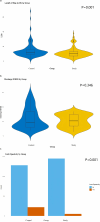Effect of PDCA-optimized good limb positioning on hemiparetic rehabilitation outcomes in acute cerebral infarction
- PMID: 40546259
- PMCID: PMC12180300
- DOI: 10.3389/fneur.2025.1554384
Effect of PDCA-optimized good limb positioning on hemiparetic rehabilitation outcomes in acute cerebral infarction
Abstract
Background: Proper limb positioning plays a vital role in the early rehabilitation of patients with acute cerebral infarction (ACI), preventing complications such as muscle atrophy and joint contractures while promoting functional recovery. However, inconsistent implementation limits its effectiveness. This study evaluates the impact of the Plan-Do-Check-Act (PDCA) cycle management model in optimizing good limb positioning and improving rehabilitation outcomes.
Methods: A prospective cohort study was conducted involving 300 hemiplegic ACI patients, with 150 patients receiving standard limb positioning care (control group) and 150 patients treated using the PDCA-optimized protocol (intervention group). The study was approved by The Ethics Committee of Central Hospital Affiliated to Shandong First Medical University (approval number: 20241104006). Outcomes included adherence rates, self-efficacy, quality of life (SF-36), activities of daily living (ADL), and secondary complications such as limb spasticity.
Results: The intervention group demonstrated significantly higher adherence rates (88.0% vs. 48.0%, p < 0.001) and improved rehabilitation outcomes, including increased self-efficacy (25.0 vs. 17.0, p < 0.001), better quality of life (66.5 ± 13.8 vs. 61.7 ± 17.2, p < 0.001), and enhanced ADL scores (62.2 ± 10.2 vs. 52.8 ± 9.9, p < 0.01). Median hospital stay was reduced (10 days vs. 12 days, p = 0.001), and limb spasticity incidence was lower in the intervention group (p = 0.001). No significant differences in discharge NIHSS scores were observed.
Conclusion: The PDCA cycle significantly enhances the implementation of good limb positioning, improving functional recovery, reducing secondary complications, and optimizing rehabilitation timelines for ACI patients. This study highlights the utility of PDCA in standardizing care practices and promoting better clinical outcomes. Further research should explore its broader application in diverse clinical settings.
Keywords: PDCA cycle; acute cerebral infarction; early rehabilitation; functional recovery; good limb positioning.
Copyright © 2025 Liu, Yao, Song and He.
Conflict of interest statement
The authors declare that the research was conducted in the absence of any commercial or financial relationships that could be construed as a potential conflict of interest.
Figures




Similar articles
-
The effect of time spent in rehabilitation on activity limitation and impairment after stroke.Cochrane Database Syst Rev. 2021 Oct 25;10(10):CD012612. doi: 10.1002/14651858.CD012612.pub2. Cochrane Database Syst Rev. 2021. PMID: 34695300 Free PMC article.
-
Application value of the FOCUS-PDCA cycle in nursing care for dysphagia in patients with cerebral infarction: a meta-analysis.Arq Neuropsiquiatr. 2025 Jun;83(6):1-8. doi: 10.1055/s-0045-1809417. Epub 2025 Jun 17. Arq Neuropsiquiatr. 2025. PMID: 40527498
-
Self-management interventions including action plans for exacerbations versus usual care in patients with chronic obstructive pulmonary disease.Cochrane Database Syst Rev. 2017 Aug 4;8(8):CD011682. doi: 10.1002/14651858.CD011682.pub2. Cochrane Database Syst Rev. 2017. PMID: 28777450 Free PMC article.
-
Multidisciplinary rehabilitation for older people with hip fractures.Cochrane Database Syst Rev. 2021 Nov 12;11(11):CD007125. doi: 10.1002/14651858.CD007125.pub3. Cochrane Database Syst Rev. 2021. PMID: 34766330 Free PMC article.
-
Yoga for stroke rehabilitation.Cochrane Database Syst Rev. 2017 Dec 8;12(12):CD011483. doi: 10.1002/14651858.CD011483.pub2. Cochrane Database Syst Rev. 2017. PMID: 29220541 Free PMC article.
References
-
- Anjos JM, Neto MG, de Araújo Tapparelli Y, Tse G, Biondi-Zoccai G, de Souza Lima Bitar Y, et al. Efficacy and safety of very early mobilization after thrombolysis in acute ischemic stroke: a randomized clinical trial. J Neurol. (2023) 270:843–50. doi: 10.1007/s00415-022-11411-5, PMID: - DOI - PMC - PubMed
-
- Salazar AP, Pinto C, Ruschel Mossi JV, Figueiro B, Lukrafka JL, Pagnussat AS. Effectiveness of static stretching positioning on post-stroke upper-limb spasticity and mobility: systematic review with meta-analysis. Ann Phys Rehabil Med. (2019) 62:274–82. doi: 10.1016/j.rehab.2018.11.004, PMID: - DOI - PubMed
LinkOut - more resources
Full Text Sources

